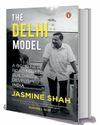
It was a closely guarded secret, and officials in the environment ministry threw red herrings all the time. While almost everyone knew Prime Minister Narendra Modi would make a big announcement, true to style, in Glasgow, there was speculation on what this would be. Would he talk about India’s Energy Swaraj by 2047 as the additional commitment or would the transcontinental solar global green grid be the big thing? So, when he announced India’s commitment to reach net-zero (emissions) by 2070, everyone did a double take. India had finally bitten the bullet, or had it? Modi’s speech was in the late afternoon when a certain drowsiness had enveloped the summit, and not just US President Joe Biden. The announcement roused everyone into exclamations and discussions, and it remained the biggest buzz at the World Leaders Summit at the United Nations Conference of the Parties (COP26), putting aside the doomsday prophecies that were earlier dominating the narrative.
The year 2070 is half a century away, and two decades behind the global north’s clarion of a 2050 deadline; none of the leaders of today are likely to be around then to call each other out. Yet, Modi’s big announcement, along with a slew of others— with 2030 as the deadline for a 45 per cent less carbon-intensive economy, a 50 per cent renewable component in the energy mix and the Indian Railways going totally powered by renewables—brought in relieved praise from India’s bilateral buddy and COP26 host, the United Kingdom. It was a commitment they wanted to this new fancy of theirs, net-zero emissions. Though India has maintained that net-zero emissions alone do not solve the climate crisis, it made the needed commitment.
Diese Geschichte stammt aus der November 14, 2021-Ausgabe von THE WEEK.
Starten Sie Ihre 7-tägige kostenlose Testversion von Magzter GOLD, um auf Tausende kuratierte Premium-Storys sowie über 8.000 Zeitschriften und Zeitungen zuzugreifen.
Bereits Abonnent ? Anmelden
Diese Geschichte stammt aus der November 14, 2021-Ausgabe von THE WEEK.
Starten Sie Ihre 7-tägige kostenlose Testversion von Magzter GOLD, um auf Tausende kuratierte Premium-Storys sowie über 8.000 Zeitschriften und Zeitungen zuzugreifen.
Bereits Abonnent? Anmelden

Forging the future
As the curtain falls on 2024, I take pride in the extraordinary milestones achieved under the leadership of Prime Minister Narendra Modi. This year stands as a testament to the Modi government's resolve to forge a resilient and forward-looking Bharat. From groundbreaking advancements in infrastructure to visionary global initiatives, these efforts resonate deeply with the vision of Viksit Bharat.

Our strange democracy
Abraham Lincoln is lauded as among the very best presidents the US ever had: the statesman par excellence successfully steered the nation through the devastating and perilous years of the American civil war. Not only did Lincoln manage to keep his country united, he also ensured the passage of the 13th amendment to the US constitution, which abolished slavery.

Five years of post-pandemic fashion
It has been five years since we discovered what Covid-19 was, and five years since it disrupted the world forever. The World Health Organization activated their emergency systems on January 1, 2020, and informed the world by January 4, 2020. By the end of that week, they had set guidelines for various countries to follow. Comparable to the Spanish flu of 1918, more than 7 million people have died of Covid according to official data. Unofficially, no one has an idea. WHO has just this week asked China to provide critical data to understand the virus's origins as a “moral and scientific imperative”.

Community spirit
Rhythm of Dammam opens a window to the world of African-origin Siddis of Uttara Kannada

'Breaking' down a scandal
Society Girl is not just a case study of a high-profile death in Pakistan but also a stark commentary on media trials

Progress card
Jasmine Shah's book tells you what the AAP has achieved in Delhi in the last 10 years

SENSE IN NONSENSE
In his latest book of poetry, Ruskin Bond is at his funniest

Get ready for Trump bump
The ‘butterfly effect’ is a beautiful, mysterious metaphor of the planet’s interconnectedness.

QUIET FLOWS THE FAITH
The melding of an ancient amorphous faith and the latest science; of an antique tradition and new practices; ways of life older than memory and new expressions is happening at Prayagraj in Uttar Pradesh.

Trash to treasure
How a weed-choked Dal Lake spurred Maninder Singh's journey to become a waste management visionary